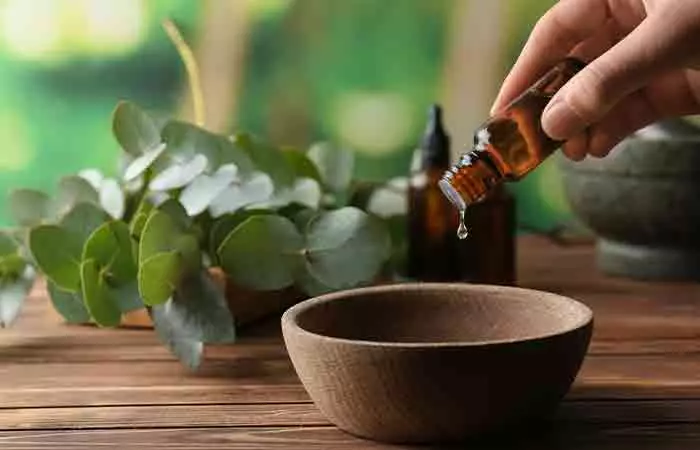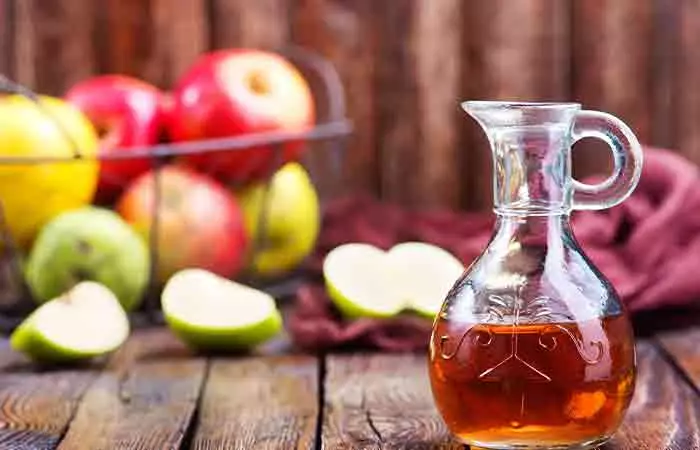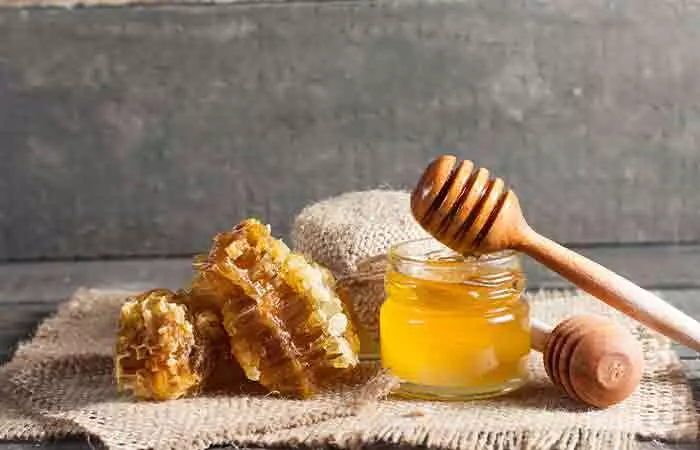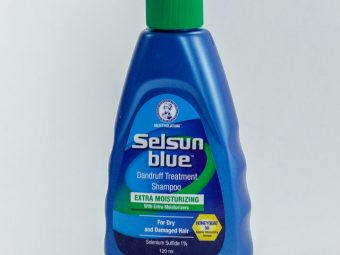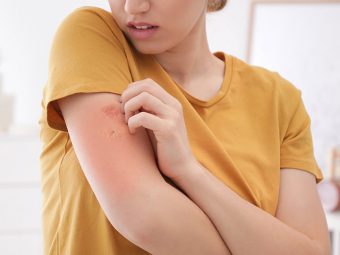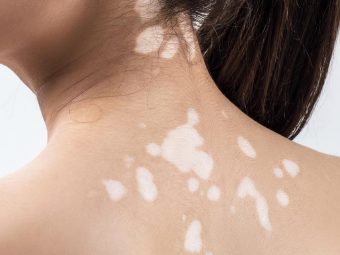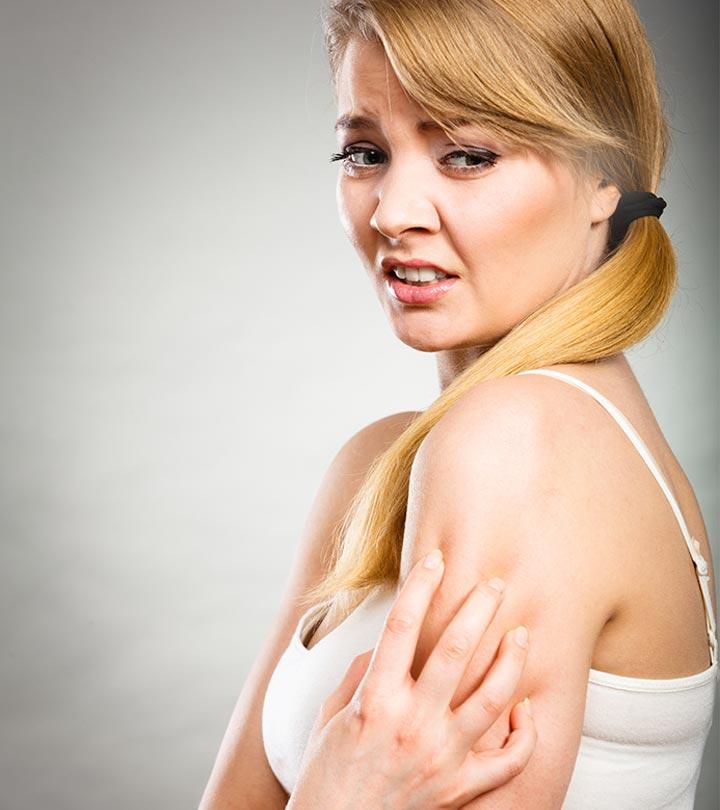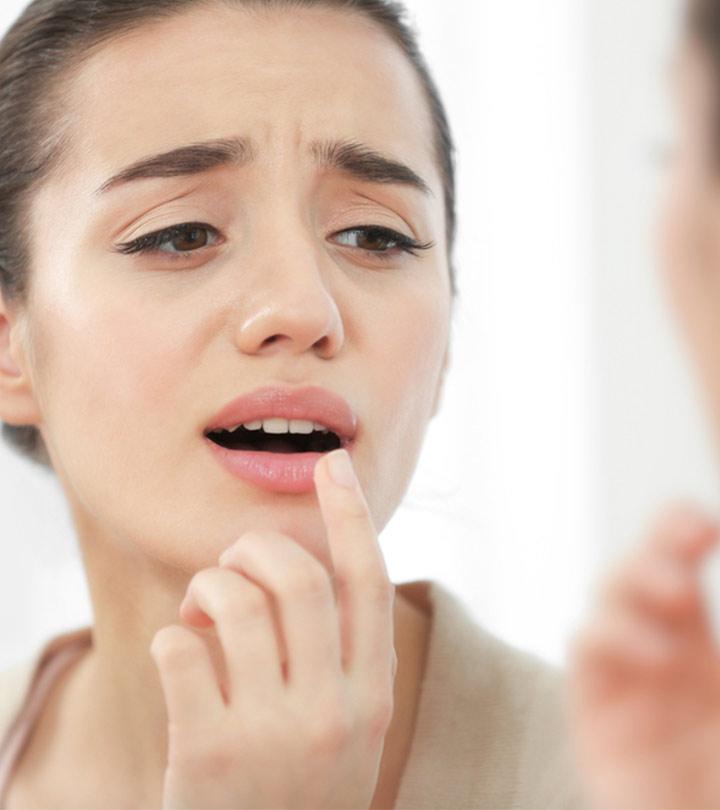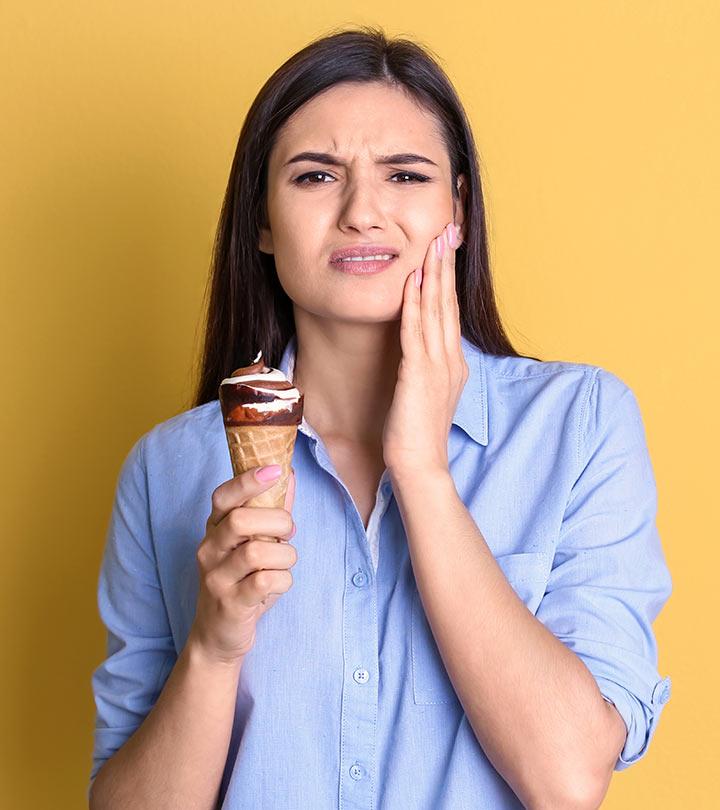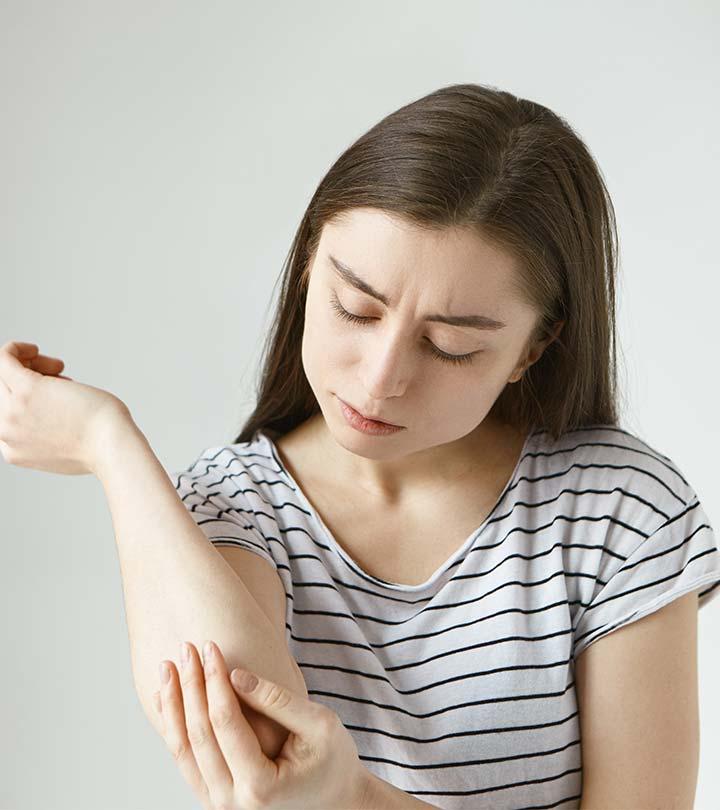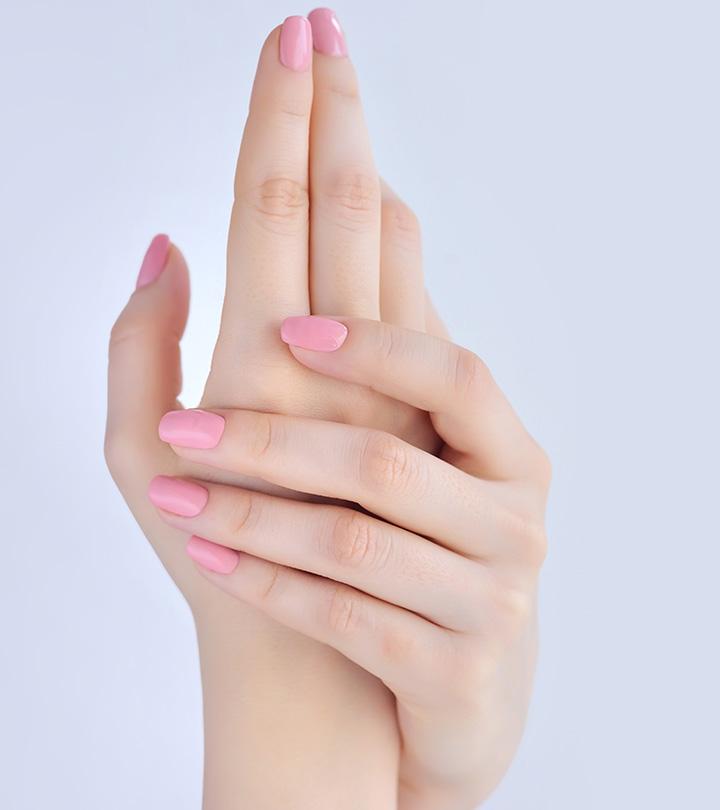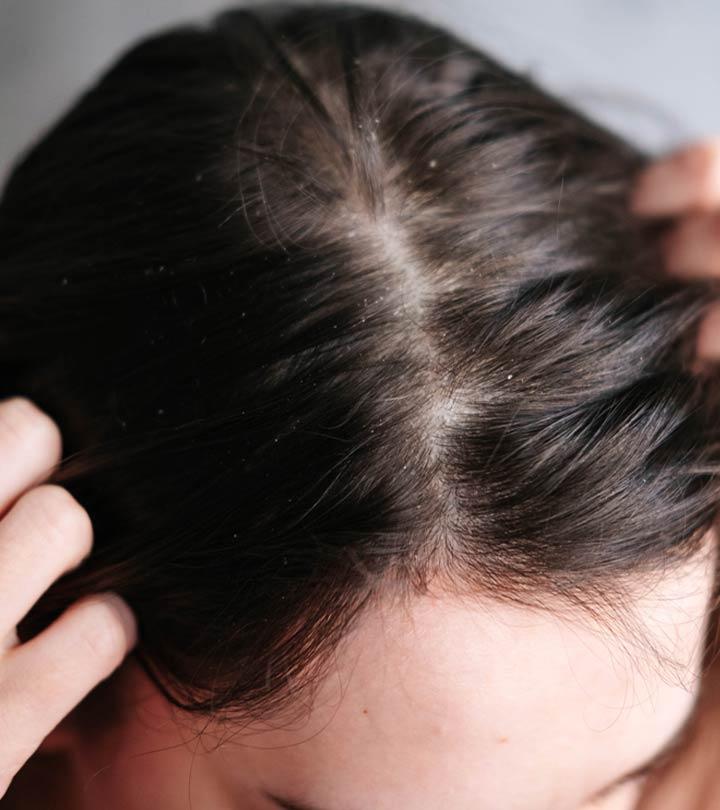How To Get Rid Of Tinea Versicolor – 15 Home Remedies To Try
Treat those discolored spots with essential oils and other natural ingredients.

Image: Shutterstock
Do you have discolored spots on the skin in various areas? If your response is yes, you have most likely got tinea versicolor, a skin infection. This article talks about how to get rid of tinea versicolor. Keep reading to know more.
In This Article
What Is Tinea Versicolor?
There is a fungus called Malassezia that lives on the surface of your skin. Although it usually doesn’t cause any health problems, this fungus can sometimes grow out of control and cause changes in the natural color of your skin. As a result, you may develop patches that are lighter or darker than the surrounding skin.
This condition is referred to as tinea versicolor. Another term used for this condition is pityriasis versicolor.
According to a study published in the Skin Health and Disease journal, the prevalence of tinea versicolor in the US is 0.67%. This prevalence rate was based on the electronic health record data of 251,597 participants, 1698 of which had tinea versicolor. Compared to the white population, Black and Hispanic participants were at a higher risk of the condition. Physically disabled participants were also found to have significantly higher odds of developing tinea versicolor than their able-bodied counterparts.
One of the main signs of the onset of this condition is a discolored patch or patches that surface on your skin. These patches occur in various forms. The following section lists the symptoms of tinea versicolor.
Signs And Symptoms Of Tinea Versicolor
The most prominent symptom of tinea versicolor are discolored skin patches that can occur on your arms, chest, neck, or even back.
These patches might be:
- Discolored as compared to the surrounding skin
- Red, brown, pink or slightly tanned
- Itchy, scaly, and dry
- More evident with tanning
- Disappear in cooler and less humid weather
The exact cause of this uncontrolled growth of Malassezia fungus is not yet established. However, some factors are known to promote the growth of this fungus and increase the risk of infection.
Causes And Risk Factors For Tinea Versicolor
Factors that can promote the growth of Malassezia fungus are:
- Hot and/or humid climate
- Sweating a lot
- Oily skin
- Weak immunity
- Hormonal changes
Some factors can increase your risk of developing this skin condition. They include:
- A family history of tinea versicolor
- Living in a subtropical climate
- Taking medications that may weaken your immune system
- Cancer
- Taking medications that may disrupt your hormonal balance
Tinea versicolor is not physically uncomfortable or contagious, however, it can make one self-conscious if it remains over a period of time. Keep reading to know more.
What Happens If Tinea Versicolor Is Left Untreated?
Tinea versicolor usually does not cause any concerning side effects and there are plenty of treatment options and over-the-counter medications available to help treat it. However, if left untreated, it may continue to persist for years (1). It may also cause lasting skin discoloration in some people.
One of the easiest ways to find out if you have developed tinea versicolor is to observe yourself physically and look for discolored patches. Your doctor may also conduct the following tests to check for the onset of tinea versicolor.
How Is Tinea Versicolor Diagnosed?
Tinea versicolor can usually be diagnosed by looking at your skin. However, if such a diagnosis is not possible, your doctor may ask to take the following tests:
- A skin scraping test that involves scraping the affected skin and observing it under a microscope for the fungus.
- Potassium hydroxide (KOH) microscopy, which involves observing scraped skin with a KOH solution under a microscope.
- Biopsy, which requires the outer layer of your skin to be tested.
- Wood’s lamp test, which involves the use of a special machine called Wood’s lamp that uses ultraviolet rays to check for the presence of fungus on your skin.
Aaron Kemper, a modern medicine blogger, explained how he struggled with Tinea Versicolor in his childhood. He states, “..Tinea versicolor ended up being much harder to treat than I imagined. From my original dermatology appointment, I had taken an oral antifungal called Ketoconazole and also applied a topical one as well. It didn’t work (i).”
If the presence of the fungus is confirmed, you can begin with the treatment almost immediately. The tinea versicolor treatment can also be initiated right at home with the help of some basic home remedies that are listed below.
How To Get Rid Of Tinea Versicolor Naturally
Home Remedies To Treat Tinea Versicolor
1. Essential Oils
a. Tea Tree Oil
You Will Need
- 7 drops of tea tree oil
- 1 teaspoon of coconut oil
What You Have To Do
- Mix seven drops of tea tree oil with a teaspoon of coconut oil.
- Apply the mixture to the affected areas.
- Leave it on for 30 to 60 minutes before washing it off.
How Often You Should Do This
You must do this 2 to 3 times daily.
Why This Works
Tinea versicolor might result in itchy and discolored skin. The anti-inflammatory properties of tea tree oil can help in relieving the itching, while its antifungal activities eliminate the fungus causing this condition (2).
b. Eucalyptus Oil
You Will Need
- 6-7 drops of eucalyptus oil
- 1 teaspoon of any carrier oil (coconut oil, jojoba oil, etc.)
What You Have To Do
- Take six to seven drops of eucalyptus oil and add a teaspoon of any carrier oil to it.
- Massage this mixture into the affected areas and leave it on for 30 to 40 minutes.
- Wash it off and pat your skin dry.
How Often You Should Do This
Do this multiple times daily.
Why This Works
Eucalyptus oil contains a compound called eugenol, which is popular for its anti-inflammatory and antimicrobial actions. It helps relieve the symptoms of tinea versicolor and can also be used to fight the Malassezia fungus (3).
c. Patchouli Oil
You Will Need
- 8 drops of patchouli oil
- 1 teaspoon of coconut oil
What You Have To Do
- Mix eight drops of patchouli oil with a teaspoon of coconut oil or any other carrier oil.
- Massage this mixture gently into the affected skin.
- Leave it on for 20 to 40 minutes and wash it off.
- You can also leave this on overnight.
How Often You Should Do This
You must do this thrice daily.
Why This Works
Patchouli oil helps soothe inflamed and itchy skin. It is also a great remedy to fight fungal infections, thanks to its antifungal properties – which also help treat tinea versicolor (4), (5).
2. Baking Soda
You Will Need
- 1-2 teaspoons of baking soda
- Water (as required)
What You Have To Do
- Take two teaspoons of baking soda and add a few drops of water to it.
- Apply the paste to the affected areas and leave it on for 20 to 30 minutes.
- Wash the mixture off with water.
- You can also mix a teaspoon of baking soda with a glass of water and consume it.
How Often You Should Do This
You must do this on a daily basis.
Why This Works
Fungi cannot survive in an alkaline environment. The pH of your skin is usually acidic. Baking soda makes it alkaline and soothes itching (6).
3. Garlic
You Will Need
Minced garlic
What You Have To Do
- Mince some garlic and extract the juice.
- Apply the garlic extract to the affected area and leave it on for 20 to 30 minutes.
- Wash it off with water.
- You can also consume two cloves of garlic daily on an empty stomach.
How Often You Should Do This
Do this twice daily.
Why This Works
Garlic is a rich source of a compound called allicin. This organosulfur compound is known for its powerful anti-inflammatory and antimicrobial activities that can be used to treat tinea versicolor and its symptoms (7).
4. Vitamins
Vitamins A, D, and E can help treat tinea versicolor. They regulate your melanin production and promote faster recovery (8), (9). These vitamins are also great antioxidants and exhibit healing properties.
These vitamins are available in spinach, turnips, kale, eggs, milk, fish, and broccoli. You can also take supplements to combat vitamin deficiency after consulting a doctor.
 Did You Know?
Did You Know?Foods rich in -Vitamin A: Milk, yogurt, cheese, oily fish, fortified low-fat spreads, liver, carrots, sweet potatoes, mango, red peppers, apricots, and papaya.
Vitamin D: Oily fish, red meat, liver, fortified foods and juices, and egg yolks.
Vitamin E: Nuts, seeds, wheat germ, and plant or vegetable oils.
5. Yogurt
You Will Need
Plain yogurt (as required)
What You Have To Do
- Take some plain yogurt and apply it directly to the affected skin.
- Leave it on for 30 minutes, after which you can wash it off with water.
How Often You Should Do This
You must do this 2 to 3 times daily.
Why This Works
Yogurt is rich in probiotics, which display antifungal activities. They can be used to treat the Malassezia fungus that causes tinea versicolor (10).
6. Coconut Oil
You Will Need
Coconut oil (as required)
What You Have To Do
- Apply coconut oil to the affected areas.
- Leave it on for 30 minutes or overnight before washing it off.
How Often You Should Do This
You must do this 2 to 3 times daily.
Why This Works
The anti-inflammatory, analgesic, and antifungal activities of coconut oil can aid the treatment of tinea versicolor. The presence of monolaurin makes coconut oil a wonderful remedy (11), (12).
7. Apple Cider Vinegar
You Will Need
- 1 tablespoon of apple cider vinegar
- 1 cup of water
- Cotton pads
What You Have To Do
- Add a tablespoon of apple cider vinegar to the water.
- Dip a cotton pad into the solution and apply it to the affected areas.
- You can also drink this solution once a day.
How Often You Should Do This
Do this 2 to 3 times daily for effective results.
Why This Works
The acetic acid in apple cider vinegar exhibits remarkable anti-inflammatory properties, which (along with the antifungal properties) help relieve the inflammation and infection associated with tinea versicolor (13).
8. Aloe Vera
You Will Need
1 tablespoon of aloe vera gel
What You Have To Do
- Take a tablespoon of aloe vera gel and gently spread it all over the affected area.
- Leave it on for about 30 minutes and then wash it off.
How Often You Should Do This
You must do this multiple times daily until you notice a difference.
Why This Works
Aloe vera’s healing nature can speed up your recovery. It also has powerful anti-inflammatory properties and acts as an antifungal medication that can help you get rid of tinea versicolor (14), (15).
9. Castor Oil
You Will Need
Castor oil (as required)
What You Have To Do
- Take a little castor oil in your hands and apply it all over the discolored skin.
- Leave it on for 20 to 30 minutes and wash it off with plain water.
- You can also keep the oil on overnight.
How Often You Should Do This
Apply castor oil multiple times on the affected area daily.
Why This Works
The ricinoleic acid (ricinoleate) in castor oil exhibits anti-inflammatory and antimicrobial activities that help treat tinea versicolor (16), (17).
10. Epsom Salt
You Will Need
- 1 cup of Epsom salt
- Water
What You Have To Do
- Add a cup of Epsom salt to a tub filled with water.
- Soak in it for 20 to 30 minutes.
- Pat your skin dry.
How Often You Should Do This
Do this once daily.
Why This Works
Epsom salt contains magnesium, which helps reduce inflammation. The topical application of Epsom salt helps in treating the inflammatory symptoms of tinea versicolor (18).
11. Grapefruit Seed Extract
You Will Need
- A few teaspoons of grapefruit seed extract
- Cotton pads
What You Have To Do
- Dip a cotton pad in a few teaspoons of grapefruit seed extract.
- Apply it to the affected skin.
- Leave it on for 30 minutes and wash it off with plain water.
How Often You Should Do This
You must do this 2 to 3 times daily.
Why This Works
Grapefruit seed extract is a powerful anti-inflammatory and antifungal remedy that can be used to combat the fungus that causes tinea versicolor (19).
12. Neem
You Will Need
- A handful of neem leaves
- Water
What You Have To Do
- Take a handful of neem leaves.
- Add water to them and blend.
- Apply the neem paste to the affected areas.
- Leave it on for about 30 minutes and rinse it off.
How Often You Should Do This
You must do this 3 to 4 times daily.
Why This Works
Neem is a popular herbal medicine. It helps reduce inflammation in your skin and fights fungal infections with its anti-inflammatory and antifungal properties (20), (21). The topical application of this herb can work wonders in treating tinea versicolor.
13. Turmeric
You Will Need
- 2 teaspoons of turmeric powder
- Water (as required)
What You Have To Do
- Take two teaspoons of turmeric powder and add a little water to make a thick paste (not runny).
- Apply the paste all over the discolored skin.
- Leave it on for about 20 to 30 minutes.
- Wash it off with water.
How Often You Should Do This
Do this thrice daily.
Why This Works
The main constituent of turmeric is curcumin, which has antifungal as well as anti-inflammatory properties that amazingly work well against tinea versicolor (22), (23). Using turmeric regularly can be one of the best hygiene practices, it helps prevent bacterial infection and reduce skin issues.
14. Candle Bush
You Will Need
- Candle bush leaves
- Olive oil (as required)
What You Have To Do
- Take a handful of candle bush leaves.
- Pour a little olive oil – just enough to make a paste.
- Leave the concoction on for about 30 minutes and rinse it off.
- You can also apply the candle bush preparation that is readily available in the market for this purpose.
How Often You Should Do This
You must do this 2 to 3 times daily.
Why This Works
Candle bush leaves contain effective antifungal compounds. Which is why they can be effective against tinea versicolor, as per a study published in Ethnopharmacology in 1994 (24).
15. Honey
You Will Need
Organic honey (as required)
What You Have To Do
- Take some honey and apply it to the affected areas.
- Leave it on for at least 30 minutes and then wash it off.
How Often You Should Do This
Do this several times daily.
Why This Works
Given the healing, anti-inflammatory, and antifungal properties of honey, it is no surprise that it can effectively treat tinea versicolor and its symptoms (25).
Along with these natural remedies, it is also important to consider diet changes for treating tinea versicolor and preventing its recurrence.
Diet Tips
If you are have tinea versicolor, you must pay extra attention to your regular diet. Following are two lists –foods that you must eat more of, and foods that are best avoided when you are suffering from tinea versicolor. Take a look.
What To Eat
- Probiotic-rich yogurt
- Low-carb foods like broccoli, green beans, avocados, etc.
- Protein-rich foods like fish, meat, eggs, and poultry
- Garlic
What Not To Eat
- Sugar
- Alcohol
- Vinegar
- Nuts
- Fruits
You must also make a few lifestyle changes to assist your recovery. This can be done by simply following these prevention tips.
Prevention Tips
- Avoid hot and humid climates.
- Do not tan or expose yourself to the sun too much.
- Try and sweat minimally.
- Do not indulge in intense exercises.
- Take a bath twice a day.
- Don’t let sweat dry up on your skin. Wipe it with a handkerchief.
 Quick Tip
Quick TipEven if you follow the prevention tips, the chances of recurrence of this condition are high. Hence, you must be at your attentive best and avoid all triggers. If you have cosmetic concerns with the appearance of tinea versicolor, consider the OTC medications in the next section.
Over-The-Counter Medications For Tinea Versicolor
For mild cases, dermatologists may typically recommend antifungal medications such as –
- Terbinafine
- Selenium sulfide
- Miconazole
- Clotrimazole
- Products with zinc pyrithione
If the condition gets severe, consult your dermatologist for appropriate treatments.
Learn how to treat tinea versicolor effectively. Check out the following video to understand the causes and symptoms of this condition and learn from an expert on how to treat it.
Infographic: Easy And Effective Ways To Get Rid Of Tinea Versicolor
Tinea versicolor is caused by a fungal infection. Therefore, it is important to treat it with remedies that have antifungal properties. Though we have provided a list of home remedies that treat the symptoms of this issue, check out the infographic below to learn the easy and effective remedies that show antifungal properties. Illustration: StyleCraze Design Team
Hot climate, humid conditions, excessive sweating, hormonal changes, etc., are some of the factors that promote the growth of Malassezia, a fungus that causes tinea versicolor. These discolored patches on the skin dent your confidence and affect the appearance of your skin. Fortunately, you can get rid of tinea versicolor not just by medical treatment but also home remedies listed above. These remedies, including essential oils, garlic, coconut oil, apple cider vinegar, aloe vera, turmeric, etc., reduce inflammation and act against fungal growth. You should also tweak your diet by including low-carb, probiotic-rich, protein-rich foods, and garlic for healthy skin.
Frequently Asked Questions
How do you get rid of tinea versicolor overnight?
Dr. Emmanuel (Michael) R. Loucas, MD, Board-Certified Dermatologist, says, “There is no way to clear it so quickly. The reason the rash presents as white spots is because of the yeast that clocks your pigment cells from making pigment when in the sun. So, we first have to treat the yeast and then have people get some sun on the areas to stimulate their pigment cells. This process can take several weeks.”
Should I moisturize tinea versicolor?
Dr. Loucas says, “Moisturizing the areas can’t hurt and will help to decrease the flaking often seen. It will treat the actual condition, but can improve its appearance.”
Is tinea versicolor the same as vitiligo?
No. Vitiligo is a result of dysfunctionality of the cells that produce melanin, while tinea versicolor is a skin condition caused by a yeast fungus called Malassezia.
How long does tinea versicolor last?
In about two weeks, the physical symptoms like scaly and dry skin will be resolved. However, it may take about 6 to 12 months for your normal skin color to be restored.
Which is the best soap for tinea versicolor?
Antifungal soaps (like Naturasil Tinea Versicolor) are often recommended as one of the treatment options of tinea versicolor. Zinc pyrithione is another soap used for treating tinea versicolor.
Which antifungal cream is best for tinea versicolor?
Topical creams containing antifungal ingredients like clotrimazole, miconazole, selenium sulfide, and terbinafine are recommended for the treatment of tinea versicolor. You can also use any of the above remedies if you are looking for natural alternatives.
Does tinea versicolor itch?
Although the discolored skin patches are not contagious or painful, they may become scaly and itchy.
Which area of your body is most affected by tinea versicolor?
Tinea versicolor can affect any part of your body, but it is most likely to affect your neck, chest, back, and arms.
Can hot showers cause tinea versicolor?
Yes. While regular washing or showering helps remove fungi and dead skin cells, hot showers favor fungal growth.
How do you know if tinea versicolor is healing?
If you observe the discoloration of your skin fade away, it means tinea versicolor is healing.
Is Vaseline good for tinea versicolor?
Anecdotal evidence suggests that Vaseline is good for tinea versicolor. However, limited research is available in this regard.
Is tinea versicolor an autoimmune disease?
No. Tinea versicolor is not an autoimmune disease.
Key Takeaways
- Tinea versicolor, a fungal skin infection, forms discolored patches on the skin surface.
- The causes of this infection include a hot or humid climate, profuse sweating, oily skin, hormonal changes, and weak immunity.
- The diagnosis is done by looking at the skin or through a skin scraping test, potassium hydroxide microscopy, biopsy, and Wood’s lamp test.
- Tinea versicolor can be treated naturally at home through essential oils, baking soda, neem, turmeric, and garlic.
- Consume food rich in probiotics and protein and low in carbs.
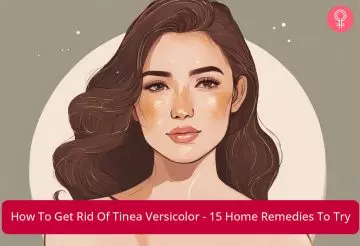
Image: Stable Diffusion/StyleCraze Design Team
Personal Experience: Source
StyleCraze's articles are interwoven with authentic personal narratives that provide depth and resonance to our content. Below are the sources of the personal accounts referenced in this article.
i. How to cure Tinea Versicolor; My personal journey;https://elkhavenherbals.wordpress.com/2016/01/19/how-to-cure-tinea-versicolor-my-personal-journey/
References
Articles on StyleCraze are backed by verified information from peer-reviewed and academic research papers, reputed organizations, research institutions, and medical associations to ensure accuracy and relevance. Read our editorial policy to learn more.
- Tinea versicolor: an updated review
https://www.ncbi.nlm.nih.gov/pmc/articles/PMC9677953/ - Melaleuca alternifolia (Tea Tree) Oil: a Review of Antimicrobial and Other Medicinal Properties, Clinical Microbiology Reviews, US National Library of Medicine, National Institutes of Health.
https://www.ncbi.nlm.nih.gov/pmc/articles/PMC1360273/ - Antimicrobial efficacy of eucalyptus oil and 1,8-cineole alone and in combination with chlorhexidine digluconate against microorganisms grown in planktonic and biofilm cultures. Journal of Antimicrobial Chemotherapy, US National Library of Medicine, National Institutes of Health.
https://www.ncbi.nlm.nih.gov/m/pubmed/19837714/ - Anti-inflammatory activity of β-patchoulene isolated from patchouli oil in mice. European Journal of Pharmacology, US National Library of Medicine, National Institutes of Health.
https://www.ncbi.nlm.nih.gov/m/pubmed/27090925/ - Antifungal effect of Allium tuberosum, Cinnamomum cassia, and Pogostemon cablin essential oils and their components against population of Aspergillus species. Journal of Food Science, US National Library of Medicine, National Institutes of Health.
https://www.ncbi.nlm.nih.gov/m/pubmed/23647469/ - Sodium bicarbonate, PubChem, US National Library of Medicine, National Institutes of Health.
https://pubchem.ncbi.nlm.nih.gov/compound/Sodium-bicarbonate#section=Therapeutic-Uses - Antimicrobial properties of allicin from garlic. Microbes and Infection, US National Library of Medicine, National Institutes of Health.
https://www.ncbi.nlm.nih.gov/m/pubmed/10594976/ - Role of vitamins in skin care. Nutrition, US National Library of Medicine, National Institutes of Health.
https://www.ncbi.nlm.nih.gov/m/pubmed/11684391/ - Vitamin E in dermatology, Indian Dermatology Online Journal, US National Library of Medicine, National Institutes of Health.
https://www.ncbi.nlm.nih.gov/pmc/articles/PMC4976416/ - Antimicrobial potential of probiotic lactic acid bacteria. Mededelingen / Faculteit Landbouwkundige en Toegepaste Biologische Wetenschappen, US National Library of Medicine, National Institutes of Health.
https://www.ncbi.nlm.nih.gov/m/pubmed/15954651/ - Anti-inflammatory, analgesic, and antipyretic activities of virgin coconut oil. Pharmaceutical Biology, US National Library of Medicine, National Institutes of Health.
https://www.ncbi.nlm.nih.gov/m/pubmed/20645831/ - In vitro evaluation of antifungal activity of monolaurin against Candida albicans biofilms. PeerJ, US National Library of Medicine, National Institutes of Health.
https://www.ncbi.nlm.nih.gov/m/pubmed/27366648/ - Antifungal Activity of Apple Cider Vinegar on Candida Species Involved in Denture Stomatitis. Journal of Prosthodontics, US National Library of Medicine, National Institutes of Health.
https://www.ncbi.nlm.nih.gov/m/pubmed/25219289/ - Antifungal activity of Aloe vera leaves. Fitoterapia, US National Library of Medicine, National Institutes of Health.
https://www.ncbi.nlm.nih.gov/m/pubmed/17336466/ - Antiinflammatory activity of extracts from Aloe vera gel. Journal of Ethnopharmacology, US National Library of Medicine, National Institutes of Health.
https://www.ncbi.nlm.nih.gov/m/pubmed/9121170/ - Synthesis and evaluation of antioxidant and antifungal activities of novel ricinoleate-based lipoconjugates of phenolic acids. Food Chemistry, US National Library of Medicine, National Institutes of Health.
https://www.ncbi.nlm.nih.gov/m/pubmed/23442675/ - Effect of ricinoleic acid in acute and subchronic experimental models of inflammation. Mediators of Inflammation, US National Library of Medicine, National Institutes of Health.
https://www.ncbi.nlm.nih.gov/pmc/articles/PMC1781768/ - Magnesium Decreases Inflammatory Cytokine Production: A Novel Innate Immunomodulatory Mechanism, The Journal of Immunology, US National Library of Medicine, National Institutes of Health.
https://www.ncbi.nlm.nih.gov/pmc/articles/PMC3884513/ - [Effects of 33% grapefruit extract on the growth of the yeast–like fungi, dermatopytes and moulds]. Wiadomości parazytologiczne, US National Library of Medicine, National Institutes of Health.
https://www.ncbi.nlm.nih.gov/m/pubmed/16886437/ - Anti-inflammatory, pro-apoptotic, and anti-proliferative effects of a methanolic neem (Azadirachta indica) leaf extract are mediated via modulation of the nuclear factor-κB pathway, Genes & Nutrition, US National Library of Medicine, National Institutes of Health.
https://www.ncbi.nlm.nih.gov/pmc/articles/PMC3092905/ - Antifungal activity of different neem leaf extracts and the nimonol against some important human pathogens, Brazilian Journal of Microbiology, US National Library of Medicine, National Institutes of Health.
https://www.ncbi.nlm.nih.gov/pmc/articles/PMC3768785/ - Anti-inflammatory properties of curcumin, a major constituent of Curcuma longa: a review of preclinical and clinical research. Alternative Medicine Review, US National Library of Medicine, National Institutes of Health.
https://www.ncbi.nlm.nih.gov/m/pubmed/19594223/ - Antifungal curcumin induces reactive oxygen species and triggers an early apoptosis but prevents hyphae development by targeting the global repressor TUP1 in Candida albicans. Bioscience Reports, US National Library of Medicine, National Institutes of Health.
https://www.ncbi.nlm.nih.gov/m/pubmed/20017731/ - A study on the therapeutic efficacy of Cassia alata, Linn. leaf extract against Pityriasis versicolor. Journal of Ethnopharmacology, US National Library of Medicine, National Institutes of Health.
https://www.ncbi.nlm.nih.gov/m/pubmed/8046939/ - Honey: A Therapeutic Agent for Disorders of the Skin, Central Asian Journal of Global Health, US National Library of Medicine, National Institutes of Health.
https://www.ncbi.nlm.nih.gov/pmc/articles/PMC5661189/





